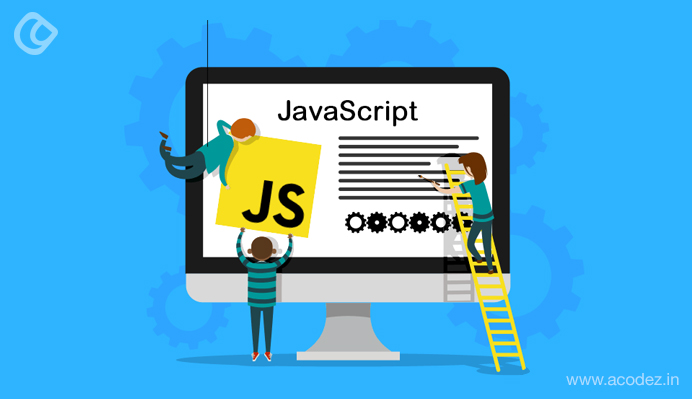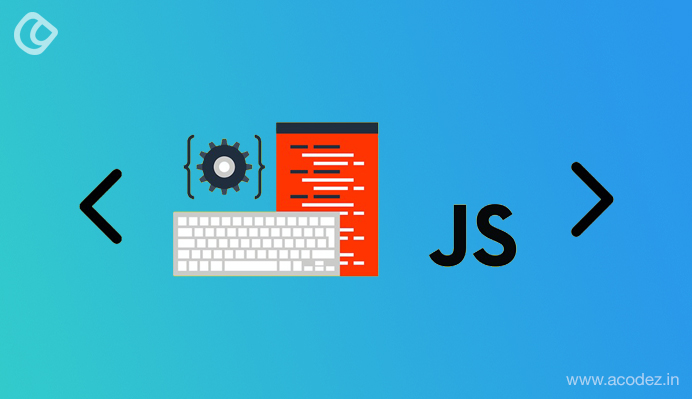HTML, CSS, and Javascript are the core technologies of the World Wide Web. Now the main question arises. What is Javascript? What is Javascript used for?
Javascript is a high-level programming language that is used widely in the modern web. It is a client-side as well as a server-side language. The features of JavaScript are vast, including dynamic programming, prototype-based object-orientation, and first-class functions. The majority of the web sites in the modern world are developed using javascript and the major web browsers use the javascript engine to execute it. Javascript helps in creating interactive web pages. It supports event-driven, functional, object-oriented, and prototype-based programming styles. Javascript greatly helps in DOM manipulation. It has flexible APIs for working with a variety of data types like strings, dates, arrays, regular expressions, etc. Syntax of javascript is also very simple and easy to learn. But don’t mistake javascript for java. Although, their names sound similar and their syntax is also quite similar, but they greatly differ in design.
Many famous javascript frameworks like AngularJS are used for developing single-page websites. Powerful Javascript libraries like ReactJS are useful while developing not only single page websites, but mobile applications also. Javascript has an important part in modern web development.
History of Javascript

Javascript was created by Brendan Eich in 1995 while he was working at Netscape communication. The web was young at that time. The mosaic browser came out as the first popular web browser. The same people who worked in the development of NCSA’s Mosaic browser were now working with Netscape communication. They were building their own browser, the Netscape communicator. With more independence and money, they started working on the expansion of the web that gave birth to javascript.
It was realized that the web needed to be more dynamic and the future web should have animations, interactions, and other automation. It could all be done by DOM interaction and for DOM interaction, a scripting language was needed. But java was on the rise at that time. This new scripting language does not need to target big-shot developers. The web was purely static at that time. HTML was also young at that time and it didn’t need big-shot developers. So the people at Netscape decided, a simple scripting language can be helpful for making the web dynamic that even the non-developers could use. Then, the idea of Mocha was born.
The sun technologies were contacted by Netscape to cut a deal to make java available in the browser. But java at the time was the only popular high-level language and needed well-skilled and experienced developers. Netscape wanted to target designers, scripters, and people with no experience of programming. Mocha was ideal for it. A simple scripting language for web and a companion of java. This is when Netscape hired Brendan Eich, also known as the father of javascript. Eich had the freedom to do what he likes but there was a lot of pressure on him. Other languages like python were also the candidates. He had to design a prototype as soon as possible. Eich started working on it and mocha’s first prototype was introduced in the Netscape communicator in 1995. Later that year, the deal between sun and Netscape closed and mocha(also called LiveScript) was renamed to Javascript. At that time, javascript was only presented as a scripting language meant only for scripting work, while the java was the original language for heavy and rich web development.
Features of JavaScript

In the starting, the power of javascript was not known. Developers saw many flaws in the language. But as the web advanced, features of javaScript became more useful. Developers soon realized that javascript was more than a scripting language.
The following are the features of javaScript.
-
DOM Manipulation
The very reason why javascript was created is DOM manipulation, which is one of the key features of JavaScript. During the early time, the web was purely static. It was made dynamic by the introduction of Javascript. So what can javascript do with the DOM? a lot many things like changing all the HTML elements on the page and all their attributes. It can also change the CSS of every HTML element on the page. Javascript can add new elements in the page and remove the existing ones. It can also create new HTML events. DOM manipulation changed the web.
The following is an example of using javascript for DOM manipulation.
<html>
<body>
<button onclick="demoFunction()">click</button>
<p id="para1"></p>
<script>
function demoFunction()
{
document.getElementById("para1").innerHTML = "Hello World!";
}
</script>
</body>
</html>
In the body tag, there is one button tag used to create a button. Javascript is used to handle the button click event and when the button is clicked, “Hello world!” appear below it. This is DOM manipulation using javascript. Observe the code in the script tag. Inside the demoFunction, the getElementById method is used to access the id of a paragraph tag below. This is how “Hello world!” is added to the DOM dynamically.
-
Functions as First-Class Objects
Functions in javascript are objects. They can have properties and methods just like any other object. Functions can be passed as arguments in other functions. They can also be thrown as exceptions. This feature of javascript is widely popular. Functions as objects are very helpful in development.
function function1(x) {
alert(x);
}
function function2(var1, callback) {
    callback(var1);
}
function2(2, function1);
In the above code, function1 along with value is passed as an argument in function2. In the function2, function1, now as callback, is used. This is how functions are passed in javascript.
-
Javascript as a Client-Side Language
Originally developed as a server-side, javascript is also used as a client-side language. This feature of javascript made it the primary language of the web. A developer does not need to learn different programming languages for server-side and client-side because javascript can be used as both.
-
Platform Independent
Javascript is a platform-independent language, which means it can run on Windows, Macintosh, Netscape-supported systems, and any other platform.
-
The Syntax is Similar to Java
Javascript was developed as a companion to java. Javascript was not intended to have similar syntax as java. But further development forced it to do so. This made it easier for developers who work in both languages.
-
Date and Time
Not many programming languages support ways for handling date and time. Javascript has inbuilt functions that easily handles dates and time.
-
Prototype-Based Object Model
In javascript, the objects have an internal property known as the prototype. These prototypes are a reference to other objects and contain common properties across all instances of the object. Prototypes are extremely useful for developers and ease their work. This prototype-based model made javascript greatly flexible and influenced many useful libraries such as Stampit.
The following code shows the use of prototypes in javascript.
function Employee(firstName, secondName, age, employeeNumber) {
  this.firstName = firstName;
  this.lastName = lastName;
  this.age = age;
  this.employeeNumber = employeeNumberl
}
Person.prototype.nationality = "English";
-
Form Validation
Forms play a very important in the modern web. The form is created using HTML but that’s not everything. Form need validation for user inputs that is necessary. Javascript handles form validation and sends data to the server with very ease.
-
Detecting the User’s Browser and OS
Although Javascript can run on every platform, there could be a need for browser and os specifications according to the code. Javascript is capable of detecting the user’s browser and OS.
-
Ability to Create Functions in the Script
This is one unique and useful feature of javascript. While writing scripts of any HTML document, a developer may need functions to handle an event and other stuff, javascript provides this option also. Functions can be created in scripts using the function keyword.
<html>
<body>
<button onclick="demo()">Click</button>
<p id="para1"></p>
</body>
<script>
function demo(){
document.getElementById("para1").innerHTML = Hello world
}
</script>
</html>
The above HTML code has a script where a function is used.
Javascript Frameworks and Libraries

In the modern world, web development frameworks and libraries are heavily used. Web frameworks are designed to support web application development. This includes web services, web APIs and web resources. The most famous web frameworks and libraries are developed using javascript. These include AngularJS, ReactJS, Vue.js, Meteor.js, Ember.js, Backbone.js and many more.
Let us check some of the Javascript libraries and frameworks.
-
AngularJS
AngularJS, being a full-fledged javascript framework, it is widely used in modern web development. It is very popular among web developers. AngularJS uses typescript, which is a superset of javascript. It has a variety of features like dependency injection, forms, templates, and more.
Check this guide on the top AngularJS frameworks.
-
ReactJS
ReactJS is a powerful javascript library that is used widely for the user interface. Its core feature is its virtual DOM that makes DOM manipulation very fast as compared to other DOM manipulation frameworks.
-
Vue.js
Vue.js is another popular javascript framework used for creating the user interface and single-page web applications.
Advantages of Javascript

Javascript is one of the core technologies of the World Wide Web. It is immensely popular because of its features. These features have many advantages that made javascript this popular.
- Javascript provides dynamic programming that is heavily used in the modern web.
- When used as a client-side language, Javascript is very fast as it runs immediately in the browser.
- One does not need to master different languages for the client-side and server-side.
- The javascript frameworks and libraries had made web development easy and straight-forward.
- Javascript is very simple to learn as compared to other programming languages like java. Being one of the core technologies of the World Wide Web, resources for javascript are easily available online and offline.
- Regardless of the file extension, We can insert javascript in any web page.
- Javascript supports all modern web browsers.
- Javascript provides extended functionalities to the web pages.
- No compiler is needed in javascript.
- Javascript is an event-based programming language.
Limitations of Javascript
There are a few limitations of javascript as well.
- One of the biggest limitations of javascript is that the code is visible to everyone.
- Javascript as the client-side does not allow the reading and writing of files.
- There are no multithreading capabilities of javascript.
- Javascript cannot be used for networking applications.
- It can be disabled.
Conclusion
Javascript is often described as the most disliked language. It was poorly designed. But it was not intended to be what it is today. From just a server-side language under the shadow of java to one of the core web technologies of the World Wide Web, javascript has covered a long distance. It is used as server-side as well as client-side. Features of javaScript are useful, yet complicated. Many languages came and diminished but javascript is still here and it will remain here for a long time, probably forever.
Acodez is a renowned web design and web development company in India. We offer all kinds of web design and web development services to our clients using the latest technologies. We are also a leading digital marketing agency providing SEO, SMM, SEM, Inbound marketing services, etc at affordable prices. For further information, please contact us.
HTML, CSS, and Javascript are the core technologies of the World Wide Web. Now the main question arises. What is Javascript? What is Javascript used for?
Javascript is a high-level programming language that is used widely in the modern web. It is a client-side as well as a server-side language. The features of JavaScript are vast, including dynamic programming, prototype-based object-orientation, and first-class functions. The majority of the web sites in the modern world are developed using javascript and the major web browsers use the javascript engine to execute it. Javascript helps in creating interactive web pages. It supports event-driven, functional, object-oriented, and prototype-based programming styles. Javascript greatly helps in DOM manipulation. It has flexible APIs for working with a variety of data types like strings, dates, arrays, regular expressions, etc. Syntax of javascript is also very simple and easy to learn. But don’t mistake javascript for java. Although, their names sound similar and their syntax is also quite similar, but they greatly differ in design.
Many famous javascript frameworks like AngularJS are used for developing single-page websites. Powerful Javascript libraries like ReactJS are useful while developing not only single page websites, but mobile applications also. Javascript has an important part in modern web development.
History of Javascript

Javascript was created by Brendan Eich in 1995 while he was working at Netscape communication. The web was young at that time. The mosaic browser came out as the first popular web browser. The same people who worked in the development of NCSA’s Mosaic browser were now working with Netscape communication. They were building their own browser, the Netscape communicator. With more independence and money, they started working on the expansion of the web that gave birth to javascript.
It was realized that the web needed to be more dynamic and the future web should have animations, interactions, and other automation. It could all be done by DOM interaction and for DOM interaction, a scripting language was needed. But java was on the rise at that time. This new scripting language does not need to target big-shot developers. The web was purely static at that time. HTML was also young at that time and it didn’t need big-shot developers. So the people at Netscape decided, a simple scripting language can be helpful for making the web dynamic that even the non-developers could use. Then, the idea of Mocha was born.
The sun technologies were contacted by Netscape to cut a deal to make java available in the browser. But java at the time was the only popular high-level language and needed well-skilled and experienced developers. Netscape wanted to target designers, scripters, and people with no experience of programming. Mocha was ideal for it. A simple scripting language for web and a companion of java. This is when Netscape hired Brendan Eich, also known as the father of javascript. Eich had the freedom to do what he likes but there was a lot of pressure on him. Other languages like python were also the candidates. He had to design a prototype as soon as possible. Eich started working on it and mocha’s first prototype was introduced in the Netscape communicator in 1995. Later that year, the deal between sun and Netscape closed and mocha(also called LiveScript) was renamed to Javascript. At that time, javascript was only presented as a scripting language meant only for scripting work, while the java was the original language for heavy and rich web development.
Features of JavaScript

In the starting, the power of javascript was not known. Developers saw many flaws in the language. But as the web advanced, features of javaScript became more useful. Developers soon realized that javascript was more than a scripting language.
The following are the features of javaScript.
-
DOM Manipulation
The very reason why javascript was created is DOM manipulation, which is one of the key features of JavaScript. During the early time, the web was purely static. It was made dynamic by the introduction of Javascript. So what can javascript do with the DOM? a lot many things like changing all the HTML elements on the page and all their attributes. It can also change the CSS of every HTML element on the page. Javascript can add new elements in the page and remove the existing ones. It can also create new HTML events. DOM manipulation changed the web.
The following is an example of using javascript for DOM manipulation.
<html>
<body>
<button onclick="demoFunction()">click</button>
<p id="para1"></p>
<script>
function demoFunction()
{
document.getElementById("para1").innerHTML = "Hello World!";
}
</script>
</body>
</html>
In the body tag, there is one button tag used to create a button. Javascript is used to handle the button click event and when the button is clicked, “Hello world!” appear below it. This is DOM manipulation using javascript. Observe the code in the script tag. Inside the demoFunction, the getElementById method is used to access the id of a paragraph tag below. This is how “Hello world!” is added to the DOM dynamically.
-
Functions as First-Class Objects
Functions in javascript are objects. They can have properties and methods just like any other object. Functions can be passed as arguments in other functions. They can also be thrown as exceptions. This feature of javascript is widely popular. Functions as objects are very helpful in development.
function function1(x) {
alert(x);
}
function function2(var1, callback) {
    callback(var1);
}
function2(2, function1);
In the above code, function1 along with value is passed as an argument in function2. In the function2, function1, now as callback, is used. This is how functions are passed in javascript.
-
Javascript as a Client-Side Language
Originally developed as a server-side, javascript is also used as a client-side language. This feature of javascript made it the primary language of the web. A developer does not need to learn different programming languages for server-side and client-side because javascript can be used as both.
-
Platform Independent
Javascript is a platform-independent language, which means it can run on Windows, Macintosh, Netscape-supported systems, and any other platform.
-
The Syntax is Similar to Java
Javascript was developed as a companion to java. Javascript was not intended to have similar syntax as java. But further development forced it to do so. This made it easier for developers who work in both languages.
-
Date and Time
Not many programming languages support ways for handling date and time. Javascript has inbuilt functions that easily handles dates and time.
-
Prototype-Based Object Model
In javascript, the objects have an internal property known as the prototype. These prototypes are a reference to other objects and contain common properties across all instances of the object. Prototypes are extremely useful for developers and ease their work. This prototype-based model made javascript greatly flexible and influenced many useful libraries such as Stampit.
The following code shows the use of prototypes in javascript.
function Employee(firstName, secondName, age, employeeNumber) {
  this.firstName = firstName;
  this.lastName = lastName;
  this.age = age;
  this.employeeNumber = employeeNumberl
}
Person.prototype.nationality = "English";
-
Form Validation
Forms play a very important in the modern web. The form is created using HTML but that’s not everything. Form need validation for user inputs that is necessary. Javascript handles form validation and sends data to the server with very ease.
-
Detecting the User’s Browser and OS
Although Javascript can run on every platform, there could be a need for browser and os specifications according to the code. Javascript is capable of detecting the user’s browser and OS.
-
Ability to Create Functions in the Script
This is one unique and useful feature of javascript. While writing scripts of any HTML document, a developer may need functions to handle an event and other stuff, javascript provides this option also. Functions can be created in scripts using the function keyword.
<html>
<body>
<button onclick="demo()">Click</button>
<p id="para1"></p>
</body>
<script>
function demo(){
document.getElementById("para1").innerHTML = Hello world
}
</script>
</html>
The above HTML code has a script where a function is used.
Javascript Frameworks and Libraries

In the modern world, web development frameworks and libraries are heavily used. Web frameworks are designed to support web application development. This includes web services, web APIs and web resources. The most famous web frameworks and libraries are developed using javascript. These include AngularJS, ReactJS, Vue.js, Meteor.js, Ember.js, Backbone.js and many more.
Let us check some of the Javascript libraries and frameworks.
-
AngularJS
AngularJS, being a full-fledged javascript framework, it is widely used in modern web development. It is very popular among web developers. AngularJS uses typescript, which is a superset of javascript. It has a variety of features like dependency injection, forms, templates, and more.
Check this guide on the top AngularJS frameworks.
-
ReactJS
ReactJS is a powerful javascript library that is used widely for the user interface. Its core feature is its virtual DOM that makes DOM manipulation very fast as compared to other DOM manipulation frameworks.
-
Vue.js
Vue.js is another popular javascript framework used for creating the user interface and single-page web applications.
Advantages of Javascript

Javascript is one of the core technologies of the World Wide Web. It is immensely popular because of its features. These features have many advantages that made javascript this popular.
- Javascript provides dynamic programming that is heavily used in the modern web.
- When used as a client-side language, Javascript is very fast as it runs immediately in the browser.
- One does not need to master different languages for the client-side and server-side.
- The javascript frameworks and libraries had made web development easy and straight-forward.
- Javascript is very simple to learn as compared to other programming languages like java. Being one of the core technologies of the World Wide Web, resources for javascript are easily available online and offline.
- Regardless of the file extension, We can insert javascript in any web page.
- Javascript supports all modern web browsers.
- Javascript provides extended functionalities to the web pages.
- No compiler is needed in javascript.
- Javascript is an event-based programming language.
Limitations of Javascript
There are a few limitations of javascript as well.
- One of the biggest limitations of javascript is that the code is visible to everyone.
- Javascript as the client-side does not allow the reading and writing of files.
- There are no multithreading capabilities of javascript.
- Javascript cannot be used for networking applications.
- It can be disabled.
Conclusion
Javascript is often described as the most disliked language. It was poorly designed. But it was not intended to be what it is today. From just a server-side language under the shadow of java to one of the core web technologies of the World Wide Web, javascript has covered a long distance. It is used as server-side as well as client-side. Features of javaScript are useful, yet complicated. Many languages came and diminished but javascript is still here and it will remain here for a long time, probably forever.
Acodez is a renowned web design and web development company in India. We offer all kinds of web design and web development services to our clients using the latest technologies. We are also a leading digital marketing agency providing SEO, SMM, SEM, Inbound marketing services, etc at affordable prices. For further information, please contact us.
Looking for a good team
for your next project?
Contact us and we'll give you a preliminary free consultation
on the web & mobile strategy that'd suit your needs best.










